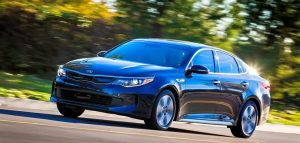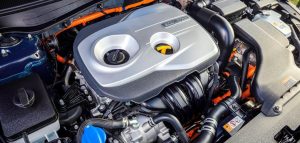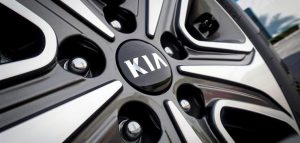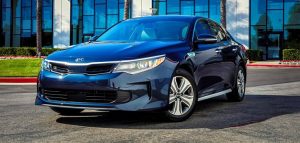What a Difference Five Years Makes
When I reviewed Kia’s first Optima Hybrid in January 2012 after its arrival in November 2011, I noted its eye-riveting styling and tech-rich standard equipment. I also commented that the Korean automaker’s first hybrid system misfired during city driving and delivered mediocre fuel economy, a calamity that was not only off-putting, but a possible deal breaker for many shoppers.

Fast forward five years, and the 2017 Kia Optima Hybrid is a completely different car. It is still distinctly an Optima, but the sheet metal is a little softer, which takes off some of the edgy styling of the outgoing model. The new hybrid continues to be tech laden, but the interior’s redesign is more upscale in appearance with higher quality materials and luxury-influenced details.
However, the biggest change is the hybrid system. It no longer stumbles and fumbles, and the fuel economy numbers have vastly improved. In short, there are no longer any deal breakers associated with the 2017 Kia Optima Hybrid.
There are two trim levels offered for 2017. The base model is priced starting at $26,890, including an $895 destination charge. Our EX test driver had a base sticker price of $31,840, with a Snow White Pearl paint job and a technology package adding $5,395 for a total of $37,235.
MPG Improvement, Now A Smooth Operator
Criticized for middling fuel economy its previous iteration, the hybrid system was meticulously rethought and reengineered, casting aside that criticism. The 2017 Kia Optima Hybrid is EPA rated at 39-mpg city/46 highway/42 combined. That compares to the 2016’s EPA numbers of 35 city/38 highway/37 combined. While the improved fuel economy numbers are not hybrid midsize class-leading—that belongs to the 2017 Toyota Prius Eco Hybrid with a combined 56-mpg—an EPA combined 42-mpg rating is nothing to sneeze at.

Much of the Optima Hybrid’s mpg improvement was achieved by jettisoning the former 2.4-liter four-cylinder gas engine and downsizing to a more efficient direct-injected 2.0-liter four. Engine output is 154 horsepower (hp) and 140 pounds-feet (lb-ft) of torque. Adding to the equation is a new electric water pump and a new electric oil pump, which help improve overall fuel economy. Additional gains come from higher voltage for the lithium-polymer battery pack and a new electric motor’s remarkable willingness to kick into electric mode, even at 62 mph (which just happens to be 100 kilometers per hour) on the interstate.
To make up the performance slack of the smaller engine, the previous 35-kilowatt electric motor was replaced by a smaller, but more powerful 38 kW unit that generates 51 hp and 140 lb-ft of torque. Under acceleration, the engine and motor pool their resources to provide a combined system output of 193 horsepower. The upshot is an eight-second 0-60 run.
As for the hybrid system’s calamity during in-town driving, Hyundai has ironed out that issue with significant changes to the six-speed automatic transmission, which houses the traction motor. The words to describe the hybrid system now are smooth and seamless.
It’s a full parallel hybrid design that permits operating in three modes: gasoline power, electric-only power and a combination of both. Like other systems of this type, it has stop-start capability to conserve fuel, as well as regenerative braking that feeds energy to the battery during slowing and braking.
Sleek And Slippery
When Kia redesigned the Optima last year they took a step back from the forward-looking, forward-thinking example of daring and aggressive design of the previous version. The new look is conservative and mature. With the 2017 Kia Optima Hybrid, the automaker put form in the service of function—better aerodynamics.
Styling is evolutionary, rather than revolutionary, building on the looks of the previous car, with Kia’s trademark grille treatment stretched wide and featuring active air louvers as well as an “air curtain” method of tuning the front-end to sweep airflow outside to front wheels and over the hood. Hybrid-specific alloy wheels help diminish wind drag, while a covered undercarriage, a rear spoiler and redesigned rear fascia improve downforce. All of these touches add up to a slick and slippery drag coefficient of just 0.24 Cd, matching the Tesla Model S electric sedan.
Exterior dimensions are marginally longer, taller and wider than the previous generation. The wheelbase has been extended to 110.4 inches (increased 0.4 inches), and the vehicle has been widened to 73.2 inches (increased 1.0 inch).
Inside there is a delicious amount of passenger space, front and rear, and the car sets a high standard for fit and finish and high-quality materials. The dash design is linear and horizontal, while an upper crease arcs around the top of the dash and through to the doors, framing the cabin for the front occupants. Buttons and switches inside improve by leaps and bounds, and you won’t have to look far to see the level of improvement here in the details. It’s one very well-coordinated cabin.

A distinctive instrument cluster with a 4.3-inch color LCD multi-purpose display lets Hybrid drivers know the status and flow of the hybrid system.
The 2017 Optima Hybrid continues Kia’s knack for creating strong showroom appeal by including hot-button features as standard. These include Kia’s UVO’s infotainment telematics system with Apple CarPlay and Android Auto, as well as Bluetooth hands-free mobile phone linking, and satellite radio, all housed in a seven-inch color touch-screen display. Add to the list an auxiliary audio jack and a USB interface for iPods and other digital media, plus a tilt/telescoping steering wheel fitted with audio, Bluetooth, and cruise controls.
There is ample room in the trunk’s 13.3 cubic feet of space to stash strollers and other kid paraphernalia. That’s thanks to Kia placing the battery pack under the trunk floor, which allows 60/40 split-folding rear seats.
The Optima Hybrid’s resume includes a full suite (seven) of airbags, a backup camera and stability and traction controls. Optional are forward collision, lane departure and blind-spot warning systems along with rear parking assist with rear cross-traffic warning and active cruise control.
On The Road
Driving the 2017 Kia Optima Hybrid is a soothing respite to the bustle and hubbub of city traffic.It’s nicely soundproofed, luxuriously appointed and pleasant to drive. Get up to speed from a stop via the gas engine, ease off the accelerator and the transition to electric power is uncannily smooth and allows all-electric driving for several miles.
Kia’s reason for choosing an automatic transmission rather than the more common hybrid continuously variable transmission (CVT) was to address the complaint that hybrids were boring to drive.
Mash the throttle and the six-speed transmission winds nicely toward top rpm, shifting each time somewhere around 6,000 rpm, when the full tug of torque seems ready to run out. So it would seem that Kia accomplished its goal of achieving a driving experience that closely parallels a conventional car.

As for handling, the car has balanced agility for the hybrid sedan class and the suspension keeps everything secure. The ride is composed and comfortable with the suspension soaking up potholes and rough pavement.
My favorite aspect of the Kia’s road manners is its responsive steering. It has a quick and precise feeling, is balanced and firm, but never twitchy.
Regenerative and hydraulic braking play a role in the hybrid system and the brake pedal felt squishy and unnatural, something I couldn’t get used to during our week with the car.
We accelerated moderately and kept pace with 70-75 mph freeway traffic. After diving 236 miles in our EX test car, nearly equally divided between city and highway driving, we averaged 42.8 mpg. What likely helped beat the EPA rating was the hybrid system’s ability to travel on electric power at freeway speeds, something I found fairly easy to do.
In The Marketplace
The 2017 Kia Optima Hybrid faces different market conditions than the 2012 model. Its two main competitors, the Fusion Hybrid and Camry Hybrid have recently been refreshed and deliver better fuel economy than the old models, as does it’s sister Hyundai Sonata Hybrid. Plus, there is now the Chevrolet Malibu that hits the street with 46-mpg combinded fuel economy rating and the Honda Accord Hybrid at 48 combined. The Prius Eco is the fuel economy leader, but really is a smaller car than this quintet.
Also, 2012 was the priciest year ever for gasoline prices, averaging $3.60 per gallon with a peak of more than $4.00. Today the national average is $2.27, which makes it tough to sell a gasoline-electric hybrid car.
At $26,890 to $31,885, the 2017 Kia Optima Hybrid is priced competitively. Ford’s Fusion Hybrid is priced from $26,660 to $38,005, while the Toyota Camry Hybrid runs from $27,795 to $30,040. Chevy’s Malibu Hybrid starts at $28,750 and tops out at $31,850 while the Hyunda Sonata Hybrid comes in at $26,835 to 30,935. And then there’s Hyundai’s new Ioniq Hybrid, a slightly smaller model coming soon.
The Warranty Boost

But the 2017 Kia Optima Hybrid offers a compelling reason to buy—Kia’s warranty. Basic coverage is five years/60,000 miles bumper-to-bumper, and 10 years/100,000 miles for the hybrid powertrain, which includes the battery pack, electric motor, gear drive unit, electric power control unit, onboard charger, the works.
Owners also receive 24-hour roadside assistance at no extra charge for five years/unlimited mileage.
Then there’s the warranty knockout punch—a lifetime warranty for the hybrid battery pack. If the lithium-polymer battery fails, Kia will replace the battery and cover recycling costs of the old battery pack free of charge to the original owner.
That’s impressive and reassuring. If for no other reason than the warranty, if you have decided it’s time to move to a hybrid, the 2017 Kia Optima Hybrid should be on your shopping list.
Related Stories You Might Enjoy:
Road Test: 2017 Ford Fusion Energi
News: 2017 Hyundai Ioniq Hybrid
Road Test: 2016 Toyota Prius
Road Test: 2017 Honda Accord Hybrid
Road Test: 2016 Toyota Camry Hybrid
Top 10 2016 Best-Selling High-MPG Cars & Trucks
Disclosure:
Clean Fleet Report is loaned free test vehicles from automakers to evaluate, typically for a week at a time. Our road tests are based on this one-week drive of a new vehicle. Because of this we don’t address issues such as long-term reliability or total cost of ownership. In addition we are often invited to manufacturer events highlighting new vehicles or technology. As part of these events we may be offered free transportation, lodging or meals. We do our best to present our unvarnished evaluations of vehicles and news irrespective of these inducements.
Our focus is on vehicles that offer the best fuel economy in their class. We also feature those that are among the top mpg vehicles in their class. In addition, we aim to offer reviews and news on advanced technology and the alternative fuel vehicle market. We welcome any feedback from vehicle owners and are dedicated to providing a forum for alternative viewpoints. Please let us know your views at publisher@cleanfleetreport.com.

Interesting, this korean producer is now making very good cars. The innovations and advanced technologies used are now close to their competitors e.g. german premium brands.
@Vin, In the same way the Japanese makers worked their way into the hearts and minds of buyers, Hyundai-Kia is putting down a solid challenge to others. We have been consistently, pleasantly surprised by the whole package they are fielding. –ed.